View in other NatureServe Network Field Guides
NatureServe
Montana
Utah
Wyoming
Idaho
Wisconsin
British Columbia
South Carolina
Yukon
California
New York
Sandbar Willow - Salix exigua
Other Names:
Coyote Willow, Narrowleaf Willow
Native Species
Global Rank:
G5
State Rank:
S5
C-value:
4
Agency Status
USFWS:
USFS:
BLM:
External Links
General Description
Shrubs to 6 m. Twigs brown, sparsely hairy to glabrous. Leaf blades 3–12 cm long, linear to narrowly lanceolate with denticulate to nearly entire margins; both surfaces green, glabrous to hairy. Female catkins 2–5 cm long, emerging with the leaves on leafy branchlets 8–30 mm long; scales yellow, hairy, deciduous. Capsules 3–8 mm long, hairy or glabrous; stipes 0–2 mm long; style <0.2 mm long (
Lesica et al. 2012. Manual of Montana Vascular Plants. BRIT Press. Fort Worth, TX).
Species Range
Montana Range
Range Descriptions
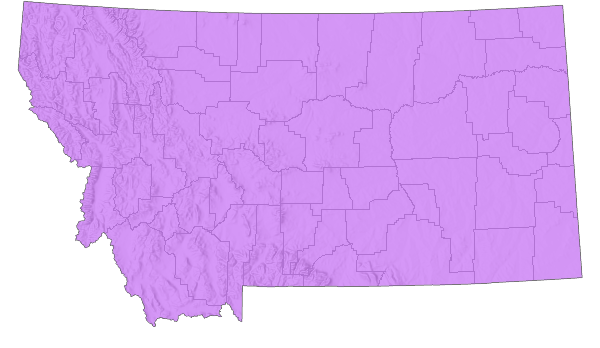
 Native
Native
Range Comments
AK to NB south to CA, LA and Mexico (Lesica et al. 2012. Manual of Montana Vascular Plants. BRIT Press. Fort Worth, TX).
Observations in Montana Natural Heritage Program Database
Number of Observations: 315
(Click on the following maps and charts to see full sized version)
Map Help and Descriptions
Relative Density
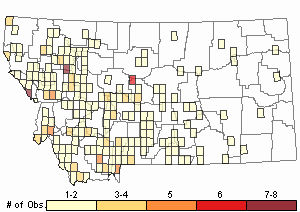
Recency
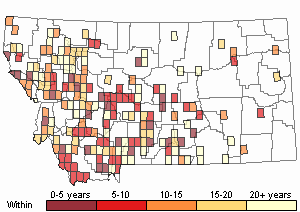
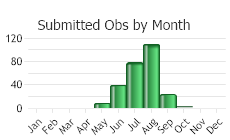
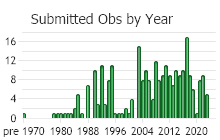
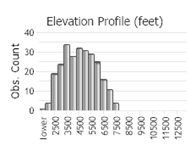 (Observations spanning multiple months or years are excluded from time charts)
(Observations spanning multiple months or years are excluded from time charts)
Habitat
National Vegetation Classification System Groups Associated with this Species
Wetland and Riparian
Riparian and Wetland Forest
Riparian Shrubland
Ecology
POLLINATORS The following animal species have been reported as pollinators of this plant species or its genus where their geographic ranges overlap:
Bombus vagans,
Bombus bifarius,
Bombus fervidus,
Bombus frigidus,
Bombus huntii,
Bombus melanopygus,
Bombus ternarius,
Bombus terricola,
Bombus sitkensis,
Bombus occidentalis,
Bombus pensylvanicus,
Bombus bimaculatus,
Bombus griseocollis,
Bombus impatiens, and
Bombus suckleyi (Plath 1934, Macior 1968, Heinrich 1976, Thorp et al. 1983, Colla and Dumesh 2010, Colla et al. 2011, Koch et al. 2012, Williams et al. 2014).
Stewardship Responsibility
References
- Literature Cited AboveLegend:
 View Online Publication
View Online Publication Colla, S., L. Richardson, and P. Williams. 2011. Bumble bees of the eastern United States. Washington, DC: USDA Forest Service, Pollinator Partnership. 103 p.
Colla, S., L. Richardson, and P. Williams. 2011. Bumble bees of the eastern United States. Washington, DC: USDA Forest Service, Pollinator Partnership. 103 p. Colla, S.R. and S. Dumesh. 2010. The bumble bees of southern Ontario: notes on natural history and distribution. Journal of the Entomological Society of Ontario 141:39-68.
Colla, S.R. and S. Dumesh. 2010. The bumble bees of southern Ontario: notes on natural history and distribution. Journal of the Entomological Society of Ontario 141:39-68. Koch, J., J. Strange, and P. Williams. 2012. Bumble bees of the western United States. Washington, DC: USDA Forest Service, Pollinator Partnership. 143 p.
Koch, J., J. Strange, and P. Williams. 2012. Bumble bees of the western United States. Washington, DC: USDA Forest Service, Pollinator Partnership. 143 p. Lesica, P., M.T. Lavin, and P.F. Stickney. 2012. Manual of Montana Vascular Plants. Fort Worth, TX: BRIT Press. viii + 771 p.
Lesica, P., M.T. Lavin, and P.F. Stickney. 2012. Manual of Montana Vascular Plants. Fort Worth, TX: BRIT Press. viii + 771 p. Macior, L.M. 1968. Bombus (Hymenoptera, Apidae) queen foraging in relation to vernal pollination in Wisconsin. Ecology 49:20-25.
Macior, L.M. 1968. Bombus (Hymenoptera, Apidae) queen foraging in relation to vernal pollination in Wisconsin. Ecology 49:20-25. Plath, O.E. 1934. Bumblebees and their ways. New York, NY: Macmillan Company. 201 p.
Plath, O.E. 1934. Bumblebees and their ways. New York, NY: Macmillan Company. 201 p. Thorp, R.W., D.S. Horning, and L.L. Dunning. 1983. Bumble bees and cuckoo bumble bees of California (Hymenoptera: Apidae). Bulletin of the California Insect Survey 23:1-79.
Thorp, R.W., D.S. Horning, and L.L. Dunning. 1983. Bumble bees and cuckoo bumble bees of California (Hymenoptera: Apidae). Bulletin of the California Insect Survey 23:1-79. Williams, P., R. Thorp, L. Richardson, and S. Colla. 2014. Bumble Bees of North America. Princeton, NJ: Princeton University Press. 208 p.
Williams, P., R. Thorp, L. Richardson, and S. Colla. 2014. Bumble Bees of North America. Princeton, NJ: Princeton University Press. 208 p.
- Additional ReferencesLegend:
 View Online Publication
View Online Publication
Do you know of a citation we're missing? Argus, G. 2010. Salix. In: Flora of North America Editorial Committee, eds. 1993+. Flora of North America North of Mexico. 16+ vols. New York and Oxford. Vol. 7.
Argus, G. 2010. Salix. In: Flora of North America Editorial Committee, eds. 1993+. Flora of North America North of Mexico. 16+ vols. New York and Oxford. Vol. 7. Bacon, L.M. 1996. Nesting ecology of the Interior Least Tern on the Yellowstone River, Montana. M.Sc. Thesis. Bozeman, MT: Montana State University. 69 p.
Bacon, L.M. 1996. Nesting ecology of the Interior Least Tern on the Yellowstone River, Montana. M.Sc. Thesis. Bozeman, MT: Montana State University. 69 p. Baril, L.M. 2009. Change in deciduous woody vegetation, implications of increased willow (Salix spp.) growth for bird species diversity, and willow species composition in and around Yellowstone National Park's northern range. M.Sc. Thesis. Bozeman, Montana: Montana State University. 124 p.
Baril, L.M. 2009. Change in deciduous woody vegetation, implications of increased willow (Salix spp.) growth for bird species diversity, and willow species composition in and around Yellowstone National Park's northern range. M.Sc. Thesis. Bozeman, Montana: Montana State University. 124 p. Boggs, K. W. 1984. Succession in riparian communities of the lower Yellowstone River, Montana. M.S. Thesis. Montana State University, Bozeman, 107 pp.
Boggs, K. W. 1984. Succession in riparian communities of the lower Yellowstone River, Montana. M.S. Thesis. Montana State University, Bozeman, 107 pp. Brammer, J.A. 1991. The effects of supersaturation of dissolved gases on aquatic invertebrates of the Bighorn River downstream of Yellowtail Afterbay Dam. M. Sc. Thesis. Bozeman, MT: Montana State University. 132 p.
Brammer, J.A. 1991. The effects of supersaturation of dissolved gases on aquatic invertebrates of the Bighorn River downstream of Yellowtail Afterbay Dam. M. Sc. Thesis. Bozeman, MT: Montana State University. 132 p. Culver, D.R. 1994. Floristic analysis of the Centennial Region, Montana. M.Sc. Thesis. Montana State University, Bozeman. 199 pp.
Culver, D.R. 1994. Floristic analysis of the Centennial Region, Montana. M.Sc. Thesis. Montana State University, Bozeman. 199 pp. Dorn, R.D. 2010. The genus Salix in North America north of Mexico. 59 pp.
Dorn, R.D. 2010. The genus Salix in North America north of Mexico. 59 pp. Eggers, M.J.S. 2005. Riparian vegetation of the Montana Yellowstone and cattle grazing impacts thereon. M.Sc. Thesis. Montana State University, Bozeman, MT. 125 p.
Eggers, M.J.S. 2005. Riparian vegetation of the Montana Yellowstone and cattle grazing impacts thereon. M.Sc. Thesis. Montana State University, Bozeman, MT. 125 p. Endicott, C.L. 1996. Responses of riparian and stream ecosystems to varying timing and intensity of livestock grazing in central Montana. M.Sc. Thesis. Bozeman, MT: Montana State University. 115 p.
Endicott, C.L. 1996. Responses of riparian and stream ecosystems to varying timing and intensity of livestock grazing in central Montana. M.Sc. Thesis. Bozeman, MT: Montana State University. 115 p. Gaffney, W.S. 1941. The effects of winter elk browsing, South Fork of the Flathead River, Montana. Journal of Wildlife Management 5(4):427-453.
Gaffney, W.S. 1941. The effects of winter elk browsing, South Fork of the Flathead River, Montana. Journal of Wildlife Management 5(4):427-453. Lesica, P., M.T. Lavin, and P.F. Stickney. 2022. Manual of Montana Vascular Plants, Second Edition. Fort Worth, TX: BRIT Press. viii + 779 p.
Lesica, P., M.T. Lavin, and P.F. Stickney. 2022. Manual of Montana Vascular Plants, Second Edition. Fort Worth, TX: BRIT Press. viii + 779 p. Little, E.L., Jr. 1979. Checklist of United States trees (native and naturalized). Agriculture Handbook No. 541. U.S. Forest Service, Washington, D.C. 375 pp.
Little, E.L., Jr. 1979. Checklist of United States trees (native and naturalized). Agriculture Handbook No. 541. U.S. Forest Service, Washington, D.C. 375 pp. Newlon, K.R. 2005. Demography of Lewis's Woodpecker, breeding bird densities, and riparian Aspen integrity in a grazed landscape. M.Sc. Thesis. Bozeman, MT: Montana State University. 101 p.
Newlon, K.R. 2005. Demography of Lewis's Woodpecker, breeding bird densities, and riparian Aspen integrity in a grazed landscape. M.Sc. Thesis. Bozeman, MT: Montana State University. 101 p. Singer, F. J. 1979. Habitat partitioning and wildfire relationships of cervids in Glacier National Park, Montana. Journal of Wildlife Management 43(2):437-444.
Singer, F. J. 1979. Habitat partitioning and wildfire relationships of cervids in Glacier National Park, Montana. Journal of Wildlife Management 43(2):437-444. Tuinstra, K. E. 1967. Vegetation of the floodplains and first terraces of Rock Creek near Red Lodge, Montana. Ph.D dissertation. Montana State University, Bozeman 110 pp.
Tuinstra, K. E. 1967. Vegetation of the floodplains and first terraces of Rock Creek near Red Lodge, Montana. Ph.D dissertation. Montana State University, Bozeman 110 pp.
- Web Search Engines for Articles on "Sandbar Willow"





